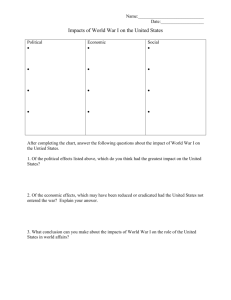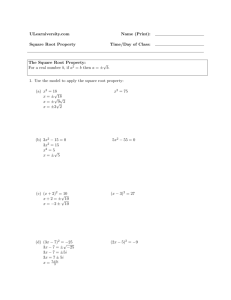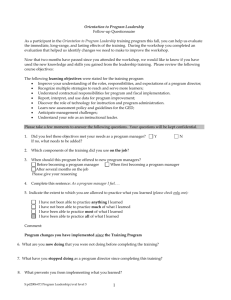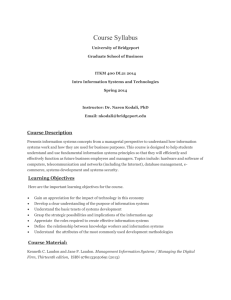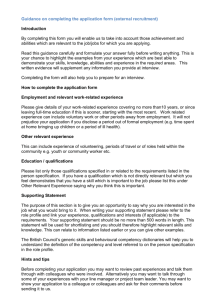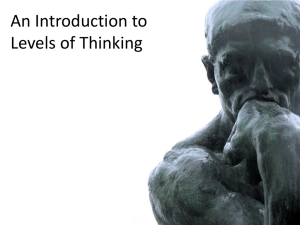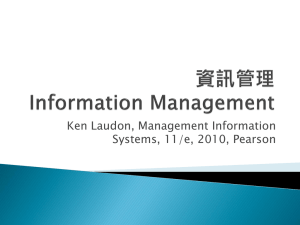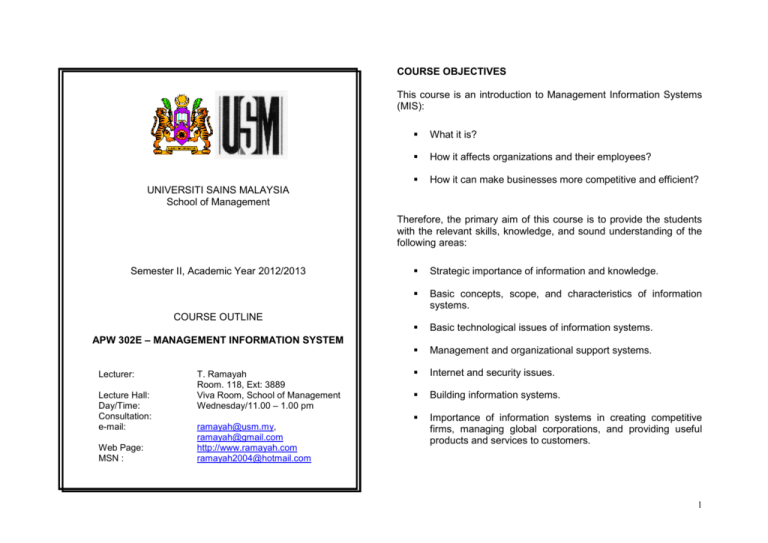
COURSE OBJECTIVES
This course is an introduction to Management Information Systems
(MIS):
What it is?
How it affects organizations and their employees?
How it can make businesses more competitive and efficient?
UNIVERSITI SAINS MALAYSIA
School of Management
Therefore, the primary aim of this course is to provide the students
with the relevant skills, knowledge, and sound understanding of the
following areas:
Semester II, Academic Year 2012/2013
COURSE OUTLINE
APW 302E – MANAGEMENT INFORMATION SYSTEM
Lecturer:
Lecture Hall:
Day/Time:
Consultation:
e-mail:
Web Page:
MSN :
T. Ramayah
Room. 118, Ext: 3889
Viva Room, School of Management
Wednesday/11.00 – 1.00 pm
ramayah@usm.my,
ramayah@gmail.com
http://www.ramayah.com
ramayah2004@hotmail.com
Strategic importance of information and knowledge.
Basic concepts, scope, and characteristics of information
systems.
Basic technological issues of information systems.
Management and organizational support systems.
Internet and security issues.
Building information systems.
Importance of information systems in creating competitive
firms, managing global corporations, and providing useful
products and services to customers.
1
At the end of the course, the students should be able to
understand the basic concept and scope of MIS.
illustrate the basic technological issues of MIS.
appreciate the strategic role of MIS in the organization.
apply real-world MIS experiences.
synthesize business and socio-legal issues in MIS.
Laudon, K. C., & Laudon, J. P. (2012). Management Information
System: Managing the Digital Firm. New Jersey: PearsonPrentice Hall Inc.
Laudon, K. C., & Traver, C. G. (2013). E-Commerce: Business.
Technology, Society, Prentice Hall.
COURSE EVALUATION
Mid semester exam
Project
Final Exam
Haag, S., & Cummings, M. (2013). Management Information
Systems for the Information Age. New York, Irwin McGrawHill.
20%
20%
60%
MAIN TEXT BOOK
Laudon, Kenneth C. and Jane P. Laudon (2012). Essentials of
Management Information Systems. New Jersey: PearsonPrentice Hall Inc.
McNurlin, B. C., Sprague, R. H. Jnr, & Bui, T. (2009). Information
Systems Management. Prentice Hall Inc.
Marakas, G. M., & O'Brien, J. A. (2013). Management information
systems.. McGraw-Hill/Irwin.
Turban, E., & Volonino, L. (2010). Information Technology for
Management: Transforming Organizations in the Digital
Economy. John Wiley & Sons, Inc.
Wallace, P. (2013). Information Systems in Organizations.
Jersey: Pearson-Prentice Hall Inc.
New
WEB REFERENCES
ADDITIONAL READING MATERIALS
Alter, S. (2002). Information Systems: The Foundation of EBusiness. Prentice Hall.
Baltzan, P. (2013). Business Driven Technology. Irewin McGrawHill.
http://www.kmnetwork.com/
http://www.businessweek.com/
Databases:
http://www.lib.usm.my/equip-usm/custom/dbusm.jsp
2
COURSE CONTENT AND SCHEDULING
Week
1
Topic
Chapter 1: Business
Information Systems
in Your Career
2
Chapter 2: Global EBusiness and
Collaboration
3
Chapter 3: Achieving
Competitive
Advantage with
Information Systems
Content
The Role of Information
Systems in Business
Today
Perspectives on
Information Systems
and Information
Technology
Understanding
Information Systems: A
Business ProblemSolving Approach
Information Systems
and Your Career
Components of a
Business
Types of Business
Information Systems
Systems for
Collaboration and
Network
The Information
Systems Function in
Business
Using Information
Systems to Achieve
Competitive Advantage
Competing on a Global
Scale
Competing on Quality
4
Chapter 4: IT
Infrastructure:
Hardware and
Software
5
Chapter 5:
Foundations of
Business
Intelligence:
Database and
Information
Management
6
Chapter 6:
Telecommunications,
the Internet and
Wireless Technology
and Design
Competing on
Business Processes
IT Infrastructure:
Computer Hardware
IT Infrastructure:
Computer Software
Managing Hardware
and Software
Technology
The Database
Approach to Data
Management
Database Management
System
Using Databases to
Improve Business
Performance and
Decision Making
Managing Data
Resources
Telecommunications
and Networking in
Today’s Business
World
Communications
Networks
The Global Internet
The Wireless
Revolution
3
7
8
9
10
Mid term exam
Chapter 7: Securing
System Vulnerability
Information Systems
and Abuse
Business Value of
Security and Control
Establishing a
Framework for Security
and Control
Technologies and
Tools for Protecting
Information Resources
Chapter 8: Achieving
Operational
Excellence and
Customer Intimacy:
Enterprise
Applications
Chapter 9: ECommerce: Digital
Markets, Digital
Goods
Enterprise Systems
Supply Chain
Management Systems
Customer Relationship
Management Systems
Enterprise
Applications: New
Opportunities and
Challenges
Electronic Commerce
and the Internet
Electronic Commerce:
Business and
Technology
The Mobile Digital
Platform and Mobile
Commerce
Building an ECommerce Web Site
11
Chapter 10:
Improving Decision
Making and
Managing Knowledge
12
Chapter 11: Building
Information Systems
and Managing
Projects
13
Chapter 12: Ethical
and Social Issues in
Information Systems
14
Decision Making and
Information Systems
Systems for Decision
Support
Intelligent Systems for
Decision Support
Systems for Managing
Knowledge
Problem Solving and
Systems Development
Alternative SystemsBuilding Approaches
Modeling and
Designing Systems
Project Management
Understanding Ethical
and Social Issues
Related to Systems
Ethics in an Information
Society
The Moral Dimensions
of Information Systems
Presentations
4
Chapter 1: Business Information Systems in Your Career
After completing this chapter, students should be able to answer the
following questions:
How are information systems transforming business and
what is their relationship to globalization?
Why are information systems so essential for running and
managing a business today?
What exactly is an information system? How does it work?
What are its people, organization, and technology
components?
How will a four-step method for business problem solving
help you solve information system-relations problems?
How will information systems affect business careers and
what information systems skills and knowledge are
essential?
Chapter 3: Achieving Competitive Advantage with Information
Systems
After completing this chapter, students should be able to answer the
following questions:
Chapter 2: E:Business: How Businesses Use Information
Systems
After completing this chapter, students should be able to answer the
following questions:
Identify and describe the major features of a business that
are important for understanding the role of information
systems.
Describe the information systems supporting the major
business functions: sales and marketing, manufacturing and
production, finance and accounting, and human resources.
Evaluate the role played by systems serving the various
levels of management in a business and their relationship to
each other.
Explain how enterprise applications collaboration and
communication
systems,
and
intranets
improve
organizational performance.
Assess the role of the information systems function in a
business.
Demonstrate how Porter’s competitive forces model helps
companies develop competitive strategies using information
systems.
Demonstrate how the value chain and value web models
help businesses identify opportunities for strategic
information system applications.
Access how information systems help businesses use
synergies, core competences, and network-based strategies
to achieve competitive advantage.
Assess how competing on a global scale and promoting
quality enhance competitive advantage.
Evaluate the role of business process reengineering (BPR) in
enhancing competitiveness.
5
Chapter 4: IT Infrastructure: Hardware and Software
After completing this chapter, students should be able to answer the
following questions:
Identify and describe the components of IT infrastructure.
Identify and describe the major types of computer hardware,
data storage, and input and output technology.
Identify and describe the major types of computer software
used in business.
Assess the most important contemporary hardware and
software trends.
Evaluate the principal issues in managing hardware and
software technology.
Chapter 6: Telecommunications, the Internet and Wireless
Technology
After completing this chapter, students should be able to answer the
following questions:
Chapter 5: Foundations of Business Intelligence: Database and
Information Management
After completing this chapter, students should be able to answer the
following questions:
Describe how a relational database organizes data and
compare its approach to an object-oriented database.
Identify and describe the principles of a database
management system.
Evaluate tools and technologies for providing information
from databases to improve business performance and
decision making.
Assess the role of information policy and data administration
in the management of organizational data resources.
Assess the importance of data quality assurance for the
business.
Describe the components of telecommunications networks
and identify key networking technologies.
Evaluate transmission media and the types of networks
available to organizations.
Demonstrate how the Internet and Internet technology work
and how they support communication and e-business.
Identify and describe the principal technologies and
standards for wireless networking, communication, and
Internet access.
Assess the business value of radio frequency identification
and wireless sensor networks.
Chapter 7: Securing Information Systems
After completing this chapter, students should be able to answer the
following questions:
Analyze why information systems need special protection
from destruction, error, and abuse.
Assess the business value of security and control.
Define an organizational framework for security and control.
Evaluate the most important tools and technologies for
safeguarding information resources.
6
Chapter 8: Achieving Operational Excellence and Customer
Intimacy: Enterprise Applications
After completing this chapter, students should be able to answer the
following questions:
Demonstrate how enterprise systems achieve operational
excellence.
Demonstrate how supply chain management systems
coordinate planning, production, and logistics with suppliers.
Demonstrate how customer relationship management
systems achieve customer intimacy.
Assess the challenges and new opportunities raised by
enterprise applications.
Determine how enterprise applications are used for crossfunctional services.
Chapter 10:
Knowledge
Chapter 9: E-Commerce: Digital Markets, Digital Goods
Describe the unique features of e-commerce, digital markets,
and digital goods.
Analyze how Internet technology has changed business
models.
Describe the various types of e-commerce and how ecommerce has changed consumer retailing and business-tobusiness transactions.
Evaluate the role of m-commerce in business and describe
the most important m-commerce applications.
Improving
Decision
Making
and
Managing
After completing this chapter, students should be able to answer the
following questions:
After completing this chapter, students should be able to answer the
following questions:
Compare the principal payment systems for electronic
commerce.
Compare different types of decisions and describe the
decision-making process.
Evaluate the role of information systems in helping people
working individually and in groups make decisions more
effectively.
Evaluate the business benefits of using intelligent techniques
in decision making and knowledge management.
Define and describe the types of systems used for
enterprise-wide knowledge management and demonstrate
how they provide value for businesses.
Define and describe the major types of knowledge work
systems and demonstrate how they provide value for firms.
Chapter 11: Building Information Systems and Managing
Projects
After completing this chapter, students should be able to answer the
following questions:
Identify and describe the core problem-solving steps for
developing new information systems.
7
Evaluate alternative methods for building information
systems.
Compare alternative methodologies for modeling and
designing systems.
Determine how information systems projects should be
selected and evaluated.
Assess requirements for successfully managing change
created by new systems.
Chapter 12: Ethical and Social Issues in Information Systems
After completing this chapter, students should be able to answer the
following questions:
Analyze the relationships among ethical, social, and political
issues that are raised by information systems.
Identify the main moral dimensions of an information society
and specific principles for conduct that can be used to guide
ethical decisions.
Evaluate the impact of contemporary information systems
and the Internet on the protection of individual privacy and
intellectual property.
Access how information systems have affected everyday life.
8

